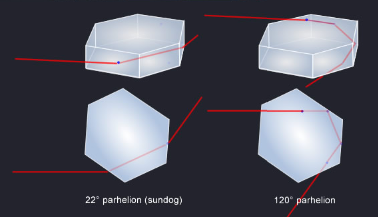120 degree parhelion and parhelic circle - OPOD
The Phenomenon of the 120 Degree Parhelion and Parhelic Circle
Atmospheric optics never cease to amaze us with their breathtaking displays. One such captivating phenomenon is the 120 degree parhelion and parhelic circle. These optical wonders occur when ice crystals in high cirrus clouds interact with sunlight, creating stunning halos that can be observed across the sky. Contrary to popular belief, these halos are not limited to Arctic regions; they can appear in various locations and seasons around the world.
The parhelic circle, a prominent feature of this atmospheric display, is a white arc that gracefully curves across the sky. When fully formed, it encircles the heavens at the same altitude as the sun and even passes through it. The parhelic circle is typically formed by horizontal plate crystals, although it can also be produced by horizontal columns. This mesmerizing arc adds a touch of ethereal beauty to the sky, captivating those fortunate enough to witness it.
One of the most fascinating aspects of the 120 degree parhelion is its colorlessness. Unlike its more common counterpart, the 22 degree parhelion or sundog, the 120 degree parhelion appears as a pure white spot along the parhelic circle. This lack of color is due to the complex ray path within the ice crystals. Rays of sunlight enter the crystal through its top face, then reflect twice internally from its vertical side faces before exiting through the bottom facet. The entrance and exit angles are equal and opposite, resulting in no dispersion of colors. Essentially, observing a 120 degree parhelion is akin to looking through a plain glass window, with no spectral hues to distract from its ethereal beauty. However, keen observers may notice a close-by blue spot, adding a subtle touch of color to the display.
While these 120 degree parhelia are undeniably mesmerizing, they are also quite rare. Their formation requires ice crystals of higher perfection compared to ordinary parhelia. Additionally, the complex ray path is best executed in thick plates or crystals with a triangular aspect, featuring alternate sides of varying lengths. These crystal requirements, combined with the lack of color, make 120 degree parhelia challenging to discern from bright patches of cloud. In situations where the cirrus clouds have thickened, resulting in a dimmer sun and a weaker halo, spotting a 120 degree parhelion becomes even more difficult.
The allure of the 120 degree parhelion and parhelic circle lies not only in their rarity but also in their ability to captivate and inspire awe. These atmospheric phenomena serve as a reminder of the intricate and magical nature of our atmosphere, constantly surprising us with its beauty. So, the next time you find yourself gazing at the sky, keep an eye out for the elusive 120 degree parhelion and parhelic circle, and let yourself be transported into a world of wonder and enchantment.

120° parhelion and parhelic circle. Imaged by Jan Curtis in New Mexico, USA. All images ©Jan Curtis, shown with permission

Ice crystals in high cirrus produced the halos. Cirrus is composed of ice crystals (or supercooled water droplets) at all seasons and places on the planet. Halos are not confined to Arctic climes.
The white arc curving across the sky is the parhelic circle. When complete it circles the sky at the same altitude as the sun and passes through it. In this case it was most likely made by horizontal plate crystals but it can also be produced by horizontal columns.
Plate crystals definitely made the colourless parhelion 120° around the parhelic circle from the sun. Its generation ray path is compared at left with that of the more common 22° parhelion or sundog. Rays enter a crystal top face then reflect twice internally from vertical side faces before leaving through the bottom facet. The entrance and exit angles are equal and opposite so there is no net dispersion into colours - take away the internal reflections and the path is equivalent to looking through a plate glass window. 120° parhelia are white (mostly!) but always look for the close-by blue spot.

Are 120° parhelia rare?
Yes, because they demand higher crystal perfection than ordinary parhelia. The complex ray path is also best executed in thick plates or ones that have a triangular aspect - alternate sides long and short. Add to that - with their lack of colour - they are difficult to discern from a bright patch of cloud. In this later image the cirrus has thickened and the sun is dimmer - a weaker halo in more patchy cloud would be hard to see.
Note: this article has been automatically converted from the old site and may not appear as intended. You can find the original article here.
Reference Atmospheric Optics
If you use any of the definitions, information, or data presented on Atmospheric Optics, please copy the link or reference below to properly credit us as the reference source. Thank you!
-
<a href="https://atoptics.co.uk/blog/120-degree-parhelion-and-parhelic-circle-opod/">120 degree parhelion and parhelic circle - OPOD</a>
-
"120 degree parhelion and parhelic circle - OPOD". Atmospheric Optics. Accessed on April 18, 2024. https://atoptics.co.uk/blog/120-degree-parhelion-and-parhelic-circle-opod/.
-
"120 degree parhelion and parhelic circle - OPOD". Atmospheric Optics, https://atoptics.co.uk/blog/120-degree-parhelion-and-parhelic-circle-opod/. Accessed 18 April, 2024
-
120 degree parhelion and parhelic circle - OPOD. Atmospheric Optics. Retrieved from https://atoptics.co.uk/blog/120-degree-parhelion-and-parhelic-circle-opod/.